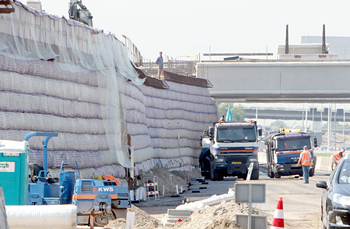 The Government Accountability Office (GAO), an independent, nonpartisan entity, is tasked with investigating how the federal government spends taxpayer dollars. Among its central work is auditing agency operations for or advising agencies on more efficient and effective spending considerations. It stands as no small matter, then, that two Congressional figures have submitted a letter to the GAO requesting the performance of a study “to investigate the life cycle costs and benefits of incorporating innovative materials in pavements.
The Government Accountability Office (GAO), an independent, nonpartisan entity, is tasked with investigating how the federal government spends taxpayer dollars. Among its central work is auditing agency operations for or advising agencies on more efficient and effective spending considerations. It stands as no small matter, then, that two Congressional figures have submitted a letter to the GAO requesting the performance of a study “to investigate the life cycle costs and benefits of incorporating innovative materials in pavements.
In their letter, Representatives John J. Duncan, Jr. (R-TN) and Frank LoBiondo (R-NJ) write:
…The House of Representatives Committee on Transportation and Infrastructure’s long-term surface transportation reauthorization proposal will address the need for innovative solutions to help bring our Nation’s transportation infrastructure to a state of good repair. The use of innovative materials in pavements has the potential to help address issues within the pavement system that affect the long-term performance of infrastructure.
Duncan serves as Chairman of the Subcommittee on Highways and Transit, and LoBiondo is Chairman of the Subcommittee on Coast Guard and Maritime Transportation.
For decades, geosynthetics such as geotextiles and geogrids have been found to offer both efficiencies in construction and better installation longevity. In paved and unpaved roads, they often reduce the amount of aggregate needed design and construction while extending service lives and reducing maintenance needs.
If the GAO takes up the study as requested, these geosynthetic materials may gain greater recognition in the nation’s roadway infrastructure improvement discussions.
The letter has in part been motivated by years of effort and dialogue between members of the Minnesota-based Geosynthetic Materials Association (GMA), Washington, D.C.-based lobbyists, and Congressional and government agency officials who have met annually for a number of years to discuss infrastructure issues, such as transportation and responsible coal ash containment.
The solid waste management sector has long required the utilization of barrier geosynthetics for environmental protection. With these materials incorporated routinely, the sector has become the highest graded sector of infrastructure in the United States (as evidenced in the American Society of Civil Engineers [ASCE] Infrastructure Report Cards). That success may influence the forthcoming decisions on coal ash management.
With the American roadway system is in need of significant re-investment, a pavement efficiencies study would be a welcomed step towards addressing the investment gap while providing more economical and more effective solutions. Geosynthetics possess a strong history in these applications and seem well-positioned to play a greater role, should the study go forth.
Read the letter from Rep. Duncan and Rep. LoBiondo on the GMA website: http://gmanow.com/gaoletter101311
Chris Kelsey is the editor of www.geosynthetica.net.











